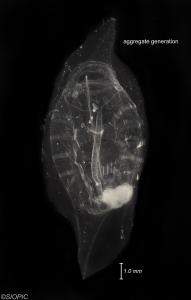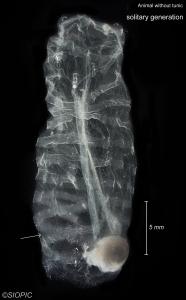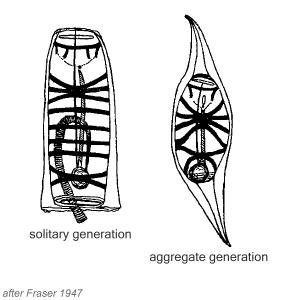Salpa fusiformis
The aggregate generation has body muscle bands 1-4 and 5-6 that fuse dorsally. In some cases, body muscle bands 4-5 are fused laterally. The aggregate zooid possesses long fusiform anterior and posterior projections and a smooth thick tunic. The solitary generation also has a smooth thick tunic, and body muscle bands 1-3 meet dorsally, and 8-9 are strongly fused.
This species can often be confused with Salpa aspera. S. fusiformis possesses less muscle fibers within the body muscle bands and a smooth tunic.
High density swarms have been reported for this species.
video source: http://www.youtube.com/watch?v=8ccMPnY0GQg
Bone, Q. (1998) The biology of pelagic tunicates. Oxford University Press, Oxford.
Foxton, P. (1961) Salpa fusiformis Cuvier and related species. Discovery Reports 32:1-32.
van Soest, R.W.M. (1974) A revision of the genera Salpa Forskal, 1775, Pegea Savigny, 1816, and Ritteriella Metcalf, 1919 (Tunicata, Thaliacea). Beaufortia 22: 153-191.
Wrobel, D. and Mills, C. (1998) Pacific Coast pelagic invertebrates: a guide to the common gelatinous animals. Sea Challengers, Monterey Bay Aquarium, Monterey, CA.
Yount, J.L. (1954) The taxonomy of the Salpidae (Tunicata) of the central Pacific Ocean. Pacific Science 8: 276-330.




